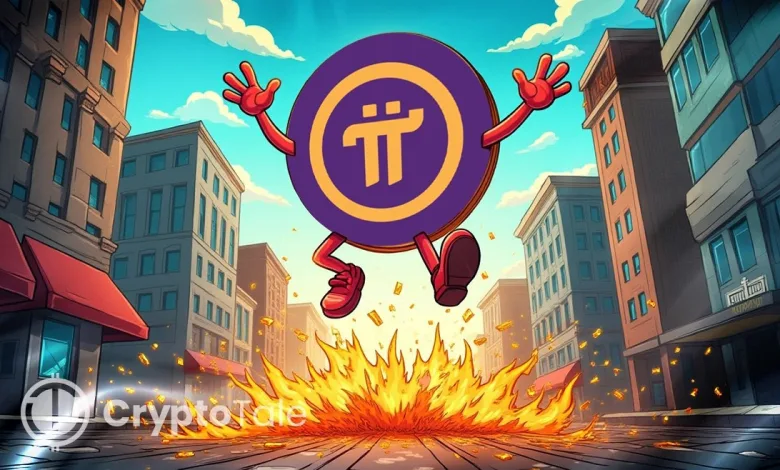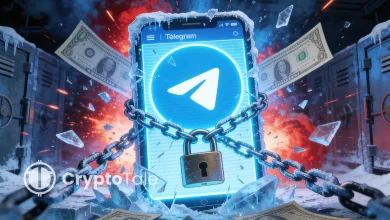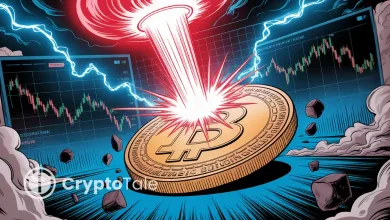Pi Network: The Sleeping Giant Moving Towards Real Utility

Pi Network is emerging as one of the most ambitious blockchain projects and a serious contender in the crypto space. According to author and crypto analyst Dr. Altcoin, Pi is undervalued and can achieve major breakthroughs.
In his X post, ahead of the release of his ebook, Pi Network: The Sleeping Giant, Dr. Altcoin emphasizes that the mobile-based blockchain project could witness significant gains as it possesses a robust user base, advanced node infrastructure, and a prominent role in the artificial intelligence (AI) sector. He also shed light on the platform’s latest initiative – Pi Hackathon 2025.
Pi Network’s Node Infrastructure Points to Hidden Strength
According to Dr. Altcoin, Pi Network has one of the largest distributed computing systems in the world, with close to 400,000 active nodes supporting its blockchain. He points out that this sheer participation provides Pi with a strong backbone, unlike other projects.
According to his estimates, these nodes combined give over one million CPU cores of computing ability, allowing the network to perform heavy workloads, like training a large open-source AI model on Pi’s network. “Such a high level of engagement is something no scam could fake,” Dr. Altcoin observed, suggesting that no fraudulent project could replicate a volunteer network of this magnitude. He described the network’s scale as making Pi “a sleeping giant” in the crypto industry.
Dr. Altcoin further emphasized that Pi’s performance has improved with the blockchain processing huge transactions within a short time, highlighting not only Pi’s consensus mechanism and infrastructure, but also its efficiency. Notably, Pi is based on the Stellar Consensus Protocol (SCP) validation system, which has low-energy transactions.
Further, Dr. Altcoin stressed that despite the operation of 400,000 nodes, the Pi Network would roughly consume 99.7% less energy than Bitcoin. This energy-light approach is part of Pi’s design as a mobile-first cryptocurrency. The ability to maintain a vast, low-energy network of nodes underscores its hidden strength and explains why Dr. Altcoin believes the project’s long-term growth is undervalued despite its current market position.
Related: PI Token Nears Breakdown as Support Weakens and Sellers Rise
AI App Studio and Robotics Investments
Beyond its core blockchain, the author highlighted the network’s venture into artificial intelligence and real-world utility. He also shed light on the Pi App Studio, an AI-powered app maker that enables users to create decentralized applications without writing code.
Launched in mid-2025, the Pi App Studio users (Pioneers) have already created more than 21,700 dApps, including chatbots and productivity tools. The no-code platform uses AI to allow non-developers to simply describe an idea and create a functional app, reducing the entry-level to blockchain development. The rise of community-created applications, which are over 7,600 chatbot-based applications, demonstrates how Pi has a large user base that is actively contributing to ecosystem growth.
Dr. Altcoin noted Pi Network’s push into AI and robotics via a $100M venture arm. Recently, the network joined a $20 million funding round for OpenMind, a startup creating OM1, an operating system likened to “Android for robots.” The move signals Pi’s strategy to link blockchain with AI by embedding the Pi token into future robotics and machine economies, boosting its potential real-world utility.
These advancements indicate that Pi Network is not a stagnant cryptocurrency project but a growing ecosystem. The Pi App Studio enables the fast development of dApps in the Pi blockchain, whereas the investment in OpenMind signals its involvement in the decentralized AI infrastructure.
Pi Hackathon 2025
The Pi Network launched the Pi Hackathon 2025 in August, and it is the first contest since its Open Network debut earlier in the year. The registration opened on August 15, and over 2,100 developers registered in the first week, representing over 100 countries worldwide.
The hackathon runs until 15 October 2025, with a midpoint check-in scheduled for 19 September. The contest has an open-ended theme, allowing developers to create any type of application, and it must integrate with Pi and deliver real-world utility. Teams face no size limit, but all members must complete KYC verification, and final submissions must include a demo video and app listing via the Pi Developer Portal. A prize pool of 160,000 Pi is on offer, with 75,000 Pi for the top project, 45,000 Pi for second place, 15,000 Pi for third, and 5,000 Pi each for up to five honorable mentions.
Global Community and Long-Term Vision for Pi Network
Dr. Altcoin also shed light on the user strength in the network. Since its inception in 2019, the number of users on Pi has increased tenfold, with more than 65 million users using the platform from over 200+ countries, and the prominent reason for the extensive adoption is that it is a free mobile mining app.
Dr. Altcoin noted that Pi’s explosive expansion has pushed the project’s infrastructure beyond initial expectations, calling it a “huge, ongoing buildout” to meet demand. According to his analysis, this widespread scope is a positive sign of interest. Still, it also means that Pi’s core team will have to be diligent about scaling both technology and governance to support a global user base.
The Pi Network emphasizes regulatory compliance and trust. More than 13 million users have already completed KYC procedures and transferred their funds to the mainnet. This massive verification, supported by strong KYC/ KYB requirements and a one address per person policy, forms a credible community of real users and eliminates fake accounts. Dr. Altcoin attributes these actions to Pi’s solid preparation for broader adoption.
Related: Pi Coin in Make-or-Break Zone After Fiat On-Ramp Boost
The author further stressed that Pi Network still has a long way to go and would require time and patience to engage before realizing its potential. He proposed that it could take another five years for it to be developed as a P2P global currency and highlighted gaps in infrastructure, real-life use cases, and major exchange listings. Further, he pointed out that a majority of Pi transactions happen within local marketplaces, limiting its liquidity and adoption, and to achieve sustainable growth, Pi will need additional business partnerships.
Nonetheless, the Pi Network community and core team continue to work toward a robust open network. Recent developments like upgrades in software nodes, improving the blockchain explorer, and integrating support for fiat on-ramping allow users to purchase Pi using credit cards, indicating its progress in terms of usability. Although exchanges like OKX and Bitget have exposed Pi in early 2025, the mainnet remains “enclosed” till the finalization of token migration.
While challenges remain around liquidity and partnerships, Pi’s user base and active development in AI and dApps suggest that it is progressing towards long-term utility. Dr. Altcoin urged Pioneers to maintain the same outlook, suggesting they follow a five-year plan with Pi Network rather than expecting overnight success.




